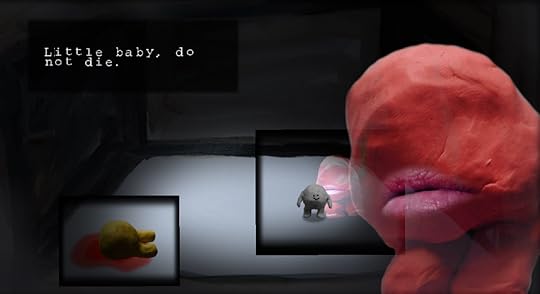Kill Screen Magazine's Blog, page 301
January 15, 2015
The Stage opens up for videogame performance art
Videogames are increasingly becoming a space of performance. Last week, during the "Awesome Games Done Quick" livestreaming marathon, I watched as a guy playing Tetris masterfully placed colorless blocks at a speed my brain couldn't register.
It's not just skill that is performed either. There are orchestras that play videogame soundtracks to live audiences. Unpredictable game glitches have been turned into dramatic musical numbers. And Façade had us explore the possibilities of a one act interactive drama with two AI actors. We're also seeing more games that ask us to perform with our bodies, such as the two-person dancing twists and twirls of Bounden, and nearly every virtual reality project out there.
The Stage isn't for Jack alone, it's meant for collaboration
Despite all of this ground being made, Jack King-Spooner's vignette project The Stage, seems to be yet another type of performance that is only now finding its feet within videogames. It was born of his admiration of performance art—gleaned from his time spent studying alongside performance artists, actors, and writers—and wanting to bring that "more explicitly" into his multimedia work.

As such, The Stage isn't for Jack alone, it's meant for collaboration, for other people to step up to and offer a performance. He mostly plays the role of a ringmaster. In Jack's words, it's "similar to a soapbox in a way, and if someone has something to say, well they can go ahead and say it on The Stage."
Before reaching out to people to work with, Jack had to establish what The Stage was, and how it could be used. He did this through making examples. "This first week has been about looking at the different forms the interactions can take, the first being Tamil Singer, to show how a musician might show their work," he told me. "Others [demonstrate] how a writer might show their work, etc."
In other words, he established the working format: a single scene (the stage), a 1280x720 resolution, and a performance that runs no longer than two minutes. The idea being to encourage "fast production, open hearts, aspiring to purer ideas, freedom of expression, expression that isn't bound by needing to please," he told me.
symbolic opposite to the multi-million dollar videogame industry.
To Jack, this is what the stage is all about. It's the symbolic opposite to the multi-million dollar videogame industry. The stage is raw, mistakes can happen, will happen, and are part of the show. This is why, as he told me, The Stage is "not a project about finished products but more about process."
Importantly, the distinction that The Stage makes from other types of game performance is that the centerpiece is not the player, but is instead each artist that shaped it. Crucially, the player only interacts with The Stage to incite the show, they do not control what happens. This is best demonstrated when an episode starts, plays a song and some repeated animation, and then ends abruptly, with the player only having moved around the stage wondering if there's anything more they can do—there isn't. They are not calling (or firing) the shots here.
Some episodes feel like their creator has just run up to you, shoved a paper script in your mouth, and stomped off after commanding, "Eat that!" You can only sit there and try to process it all.

Truly, the many vignettes that Jack has already produced for The Stage speak for themselves. You should play them all for their variety. They include a short story about a girl who can't stop eating, a song called "Jesus is my Boyfriend," and an absurd sketch about a dying baby. Comedy and horror is played interchangeably, day-by-day. So far, he's had seven people take the stage for themselves (six credited, one anonymous), providing scripts for Jack to mold his claymation figures around, their own graphics for him to set as a backdrop, weird characters and estranged sounds for him to insert.
At the moment, he's looking to open up The Stage to different types of people, especially those who aren't already making games. He's talking to actors, writers, and other artists, essentially offering up his virtual stage and his game-making skills to act as a puppet to any short burst of expression they can muster.
You can check out all the episodes of The Stage on its website. You can support Jack King-Spooner through Patreon.
I fell in love with a sex ninja at the end of the world
How Apocalypse World sets players free by taking away control.
January 14, 2015
Playlist: A wintry walk in the woods from the team behind Night in the Woods
Sign up to receive each week's Playlist e-mail here!
Also check out our full, interactive Playlist section.
LOST CONSTELLATION (WIN, MAC, LIN)
BY FINJI
How many snowballs would you store under your cape if you were an alligator (who also happens to be an astronomer) walking through a snowy forest at night? In Lost Constellation, from the team behind Night in the Woods, that figure is seemingly limitless. You can throw the snowballs at bottles that hang from trees and make ethereal, chime-like music. You can use them to build snowman after snowman. You can also use your snowball stash as a metaphor for Lost Constellation as a game; it only takes an hour to get through the forest but, considering its beauty, who could blame you for hoarding moments like they were snowballs?

Perfect for: Lovers of bedtime stories, owners of central heating.
Playtime: An hour or a long, beautiful night.
Escape the icy clutches of an inuit legend in Beneath Floes
Gather round your laptop, grab some hot cocoa, and prepare yourself for a bed story.
Be complicit in the post-modern monomyth with this art gallery simulator
Full title, no joke: Let's Play: Let's Play: Ancient Greek Punishment: Art Edition Edition.
The videogame and ghost story that led internet sleuths to break into a Texas cemetery
im null makes a performance out of virtual horror art.
Soon you’ll be able to own Marty McFly’s self-tying, LED-equipped Nikes
“Power laces, alright!”
Marty McFly was first shown the Nike Air MAG trainer on September 8, 2015 in Back to the Future II, a future where shoes have LEDs and tied themselves. It turns out that the film wasn’t so far off the mark.
Back in 2011, Nike auctioned off 1,500 pairs of the shoes—LEDs and everything. In the after-market, the kicks went for thousands of dollars, but, thankfully, designer Tinker Hatfield has an update for seekers of the futuristic footwear. Hatfield took to the stage at the Agenda Emerge creative and brand-building conference in Long Beach, California, to announce that sometime in 2015, we’ll all have our LED-illuminated shoes.
He did, however, clarify that we have “11 and two-thirds months left in 2015,” so there is no clear-cut release date yet, unless that scene from Back to the Future II comes full circle.
The patent for the lacing system was first spotted back in 2010, although the design has changed. The shoes have once again lost the “Air” moniker, as, with the 2011 design, there is no room for the Air cushions. Instead, other than the Power Laces, there is a weight sensor. The weight sensor is a noteworthy addition. Perhaps, hoaxes like HUVr aside, our near-future includes the hoverboards to match the self-tying kicks.
h/t to NiceKicks
Monopoly gets updated; prepare to gather round Austerity!
British journalists make the classic boardgame relevant to today's players.
Notes from Underground
A critical reevaluation of Dig Dug, one of classic arcade gaming’s strangest beauties.
January 13, 2015
Death, dismemberment, and abstract horror comes to Twitter
If your relationship with Twitter is anything like mine, you might welcome the addition of a bloodthirsty mystical beast to your timeline. That's exactly what developer Terence Eden has done with @wnd_go, a brief and deeply abstract Choose Your Own Adventure that uses the social media service as its platform.
The game begins in media res:
— A dreadful start (@wnd_go) January 11, 2015
There's a hint of the comic to that start, but as the story continues it adopts a more magisterial tone. Almost every path ends with something like this:
— Soon (@wnd_soon) January 11, 2015
Eden's commitment to Twitter is absolute. While the famous 120-character limit leads to, obviously, terse little dispatches like those above, he develops the mood further with apocalyptic header photos, mordant Tarot-card user-photos and colorful "real" names, such as "Fear itself fears me."
Snake your way through the postapocalyptic hellscape and you'll wind up, natch, linked to an ebook for The Wanderer by Timothy J. Jarvis. Still, over at his blog, Eden describes this all as less a case of "viral marketing" and more of an earnest tip of the hat. The idea to make a choose your own adventure game via Twitter had hit him, and, since he'd just gotten done reading Jarvis's eldritch horror novel, he gave the author's style a go. "I thought I'd try my hand at creating a viral 'teaser trailer' for Timothy's book," Eden writes. "With his blessing, I got cracking."
The result is better and weirder than whatever else you're supposed to be doing this Tuesday morning. And anyway, Twitter could use a touch of the fantastical.
Kill Screen Magazine's Blog
- Kill Screen Magazine's profile
- 4 followers



